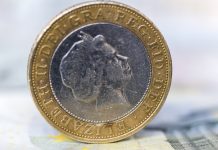Disappointing UK economic growth in addition to in line US inflation resulted in the pound falling versus the US dollar on Friday. This was the third straight session of falls for the pound against the US dollar.
| What do these figures mean? |
|---|
|
When measuring the value of a pair of currencies, one set equals 1 unit and the other shows the current equivalent. As the market moves, the amount will vary from minute to minute. For example, it could be written: 1 GBP = 1.28934 USD Here, £1 is equivalent to approximately $1.29. This specifically measures the pound’s worth against the dollar. If the US dollar amount increases in this pairing, it’s positive for the pound. Or, if you were looking at it the other way around: 1 USD = 0.77786 GBP In this example, $1 is equivalent to approximately £0.78. This measures the US dollar’s worth versus the British pound. If the sterling number gets larger, it’s good news for the dollar. |
The pound slipped on the last day of the previous week after data showed that economic growth in the UK was weaker than what analysts had been expecting. Analysts had pencilled in economic growth reaching 1.3% in the final reading of the second quarter. However, the GDP was just 1.2%, whilst the previous quarter was also revised down to 1.1%.
UK consumers have been offering support to the UK economy through strong spending habits. However, business investment has fallen sharply as Brexit jitters impact on business decisions and the economy. The weaker than forecast data sent the pound lower.
| Why does poor economic data drag on a country’s currency? |
|---|
| Slowing economic indicators point to a slowing economy. Weak economies have weaker currencies because institutions look to reduce investments in countries where growth prospects are low and then transfer money to countries with higher growth prospects. These institutions sell out of their investment and the local currency, thus increasing supply of the currency and pushing down the money’s worth. So, when a country or region has poor economic news, the value of the currency tends to fall. |
As the new week kicks off Brexit and domestic UK politics will be in focus. As the UK Conservative party annual conference begins, UK Prime Minister Theresa May is under mounting pressure. Theresa May and her Chequers Brexit plan have already been under fire from ex Foreign Minister Boris Johnson. Additionally, ex Cabinet Minister Dominic Grieve has also threatened to oust Theresa May and create a Remainer national unity party. This party would then push a second Brexit referendum through.
Political uncertainty could dampen demand for the pound. Meanwhile, any hopes of a softer Brexit, or even a second referendum could help lift sterling.
| Why is a “soft” Brexit better for sterling than a “hard” Brexit? |
|---|
| A soft Brexit implies anything less than UK’s complete withdrawal from the EU. For example, it could mean the UK retains some form of membership to the European Union single market in exchange for some free movement of people, i.e. immigration. This is considered more positive than a “hard” Brexit, which is a full severance from the EU. The reason “soft” is considered more pound-friendly is because the economic impact would be lower. If there is less negative impact on the economy, foreign investors will continue to invest in the UK. As investment requires local currency, this increased demand for the pound then boosts its value. |
Dollar Traders Shrug Off Slightly Softer US Inflation
The dollar managed to finish the week higher versus the pound, as investors shrugged off marginally disappointing inflation numbers. The personal consumption expenditure, the Fed’s preferred measure of inflation, dipped by more than what analysts had been expecting. The PCE fell t just 0% month on month, lower than the 0.2% in August and below the 0.1% expected. On an annual basis PCE inflation remained in line with analysts’ forecasts at 2%.
Investors were able to brush off the marginal weakness given that recent US data has been so encouraging. Furthermore, the Federal Reserve remain aggressive with their path of hiking and this slight miss is unlikely to be focused on too intently at the Fed.
Today the focus will stay with the economic calendar, this time on manufacturing figures.
This publication is provided for general information purposes only and is not intended to cover every aspect of the topics with which it deals. It is not intended to amount to advice on which you should rely. You must obtain professional or specialist advice before taking, or refraining from, any action on the basis of the content in this publication. The information in this publication does not constitute legal, tax or other professional advice from TransferWise Inc., Currency Live or its affiliates. Prior results do not guarantee a similar outcome. We make no representations, warranties or guarantees, whether express or implied, that the content in the publication is accurate, complete or up to date. Consult our risk warning page for more details.
This article was initially published on TransferWise.com from the same author. The content at Currency Live is the sole opinion of the authors and in no way reflects the views of TransferWise Inc.





